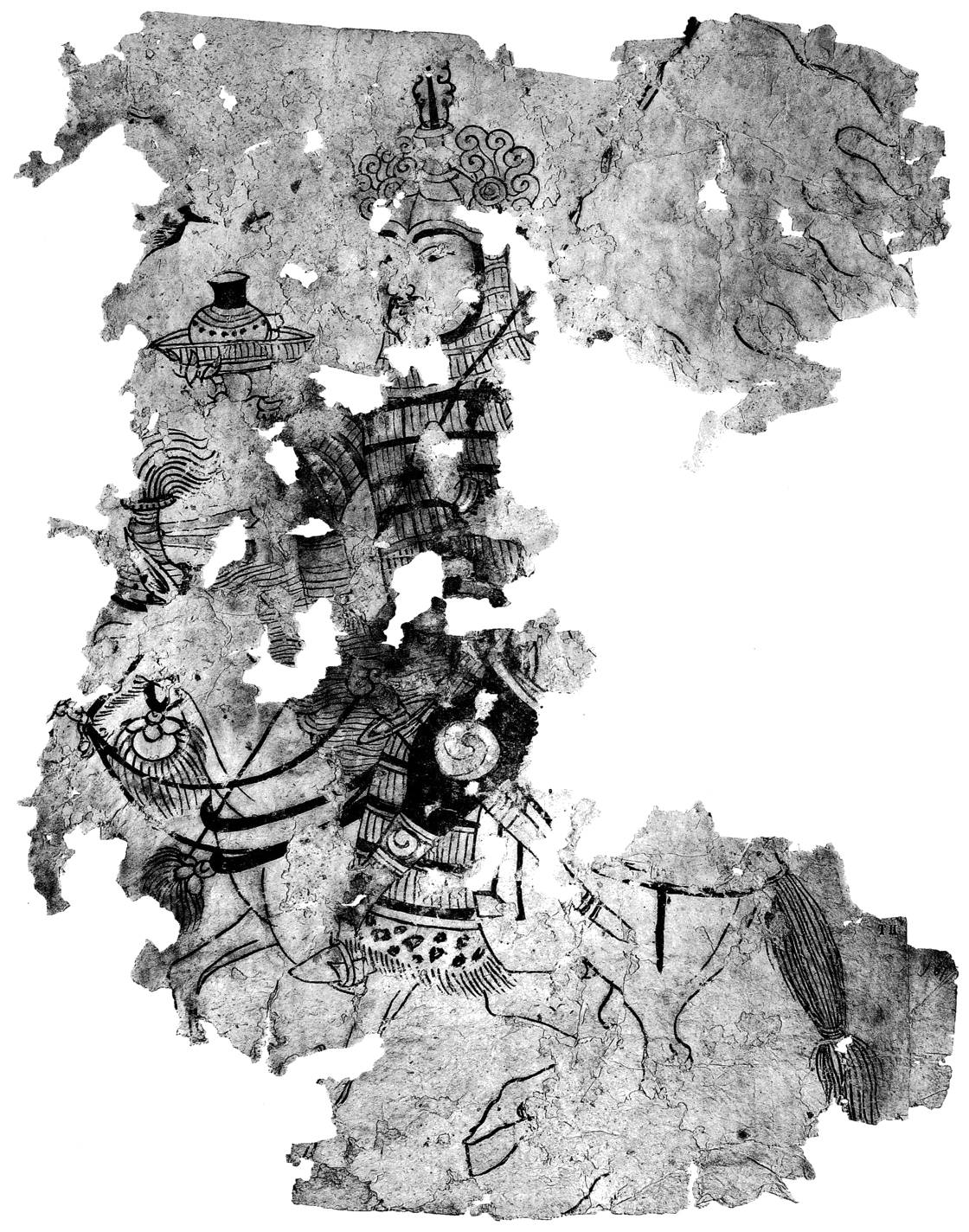Find the perfect fit with Amazon Prime. Try Before You Buy.

Amazon Audible Gift Memberships
Manuscript from the Tarim Basin
Picture of a cavalryman in the city on the Yâr

An even larger image of the cavalryman in the city on the Yâr
Reiterbildnis aus der Stadt auf dem Yâr
Source: National Institute of Informatics - Digital Silk Road Project
Translation of the description in German:
The face of the rider shows East Asian traits; slit, slightly slanted eyes and the weak, drooping mustache. The head is covered with a faint light blue paint, so is probably a steel helmet, on its centre is provided a large tubular attachment for accommodating the crest. On each side of the helmet above the ears, is located a round ornament plate, from the top and rear spirally winding lines emerge, which together form a wing-like object. The whole thing is obviously a misunderstood representation of the known Sassanid wing helmet. The face of the warrior is surrounded by a wide strip that edges the coif of elongated platelets (made of "cuir bouilli" or iron). This neck protection seems to be attached to the rim of the helmet. The colour of the plates obtained here and there is a bright greenish blue.
The entire body of the warrior is reinforced with a composite of similar, even larger armoured, platelets, the upper and lower ends of each platelet row are covered by a broad, red or reddish brown band which is made apparently from the same material as the edging of the Hauberk.
The right arm of the rider is raised, unfortunately, only the upper arm and the hand is well preserved. The forearm is badly damaged, and he does not seem to have put on the armoured sleeves, because this seems to hang down at the elbow, it is visible between the body line of the rider and the ends of the hair of the horse's flying mane. (However, it is striking that the platelets here are in the wrong direction and are perhaps something else.) In his raised hand the rider carries a round decorated offering dish with high sides. On this deep dish is a rounded vessel with short, brown-red coloured top with bent neck, below the neck are three jewelry lines including a series of eight brown red dots. The spout of the vessel is directed toward the rider. Above the vessel floats a bird with outstretched wings, apparently about to settle down on the proffered vessel. Whether the subject matter appearing on the right above the dish head and neck is another bird, I leave undecided.
The left arm is completely destroyed. Only the hand is visible, it appears not to be armoured and he holds the shaft carried on the left shoulder.
A flag whose reddish-coloured five-tailed cloth flutters behind the rider's head. The flag also served as a lance. Unfortunately, the shoulder and elbow are so damaged that you can not tell whether their protection or special equipment were attached to the armour - above and to the right of the left hand is a black loop-like object that could have possibly been used to attach a special shoulder plate : a similar object seems to be just visible on the left (on the right chest of the figure).
Similarly, it is impossible to detect any part of the saddle. The shape of the horse is severely damaged; on the head you can see the listening ear upright. Beneath the jaw depends a large bluish flower bud from which trails bulging red tassel hair. A similar puff of a bluish color is located on the centre of the lower chest belt. Carried on the head of the horse is a funnel-like attachment, perhaps of the same type as the armour material, from which protrudes a tuft of flowing hair. The neckline is indicated by the flying mane hair. The entire posterior curve of the spine is missing. The tail extends right down to the ground (of a very small horse) the lower third either tucked into a knot or tied with ribbons.
Although this is very fragmentary, it is claimed after careful consideration, that it is a later, East Asian influenced, representation of the older settlements in the country often depicting legendary events (cf. MA Stein, Ancient Khotan, Oxford, 1907, Plate LIV and Plate LXII, together with associated text.)
Referenced in Attila and the Nomad Hordes by David Nicolle (Author), Angus McBride (Illustrator), p29:
A damaged drawing from Yarkhoto probably illustrates an Uighur warrior carrying a white banner. His bowcase is designed for a strung weapon, his sword has a slight curve and he appears to have the armour of his lower right arm loosened. (Staatliche Mus. Preuss. Kulturbesitz, MIK III 17, West Berlin)
Previous: Armoured Men from Karashahr Next: Wall Paintings from a Christian Temple, Chotscho, Tarim Basin
Back to the smaller image of a cavalryman in the city on the Yâr, Tarim Basin


